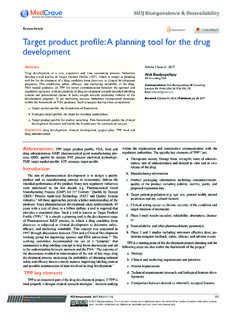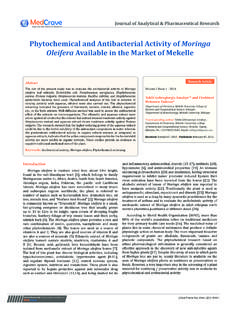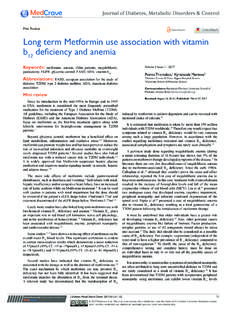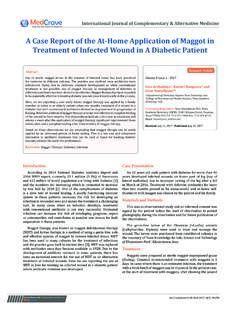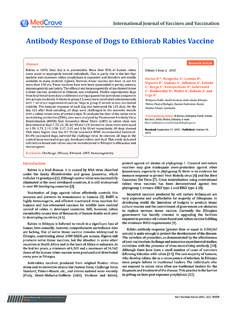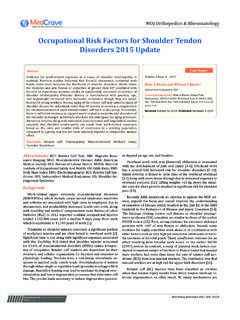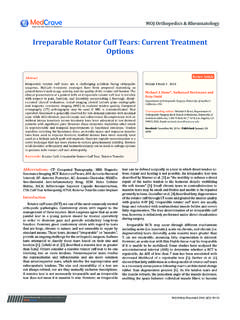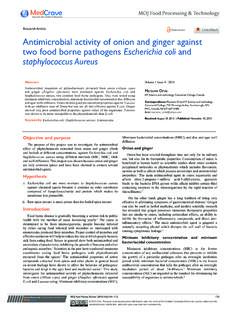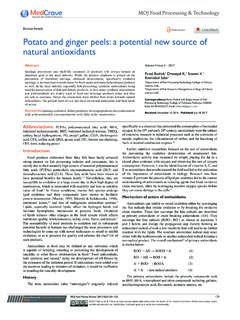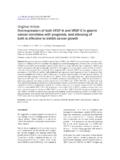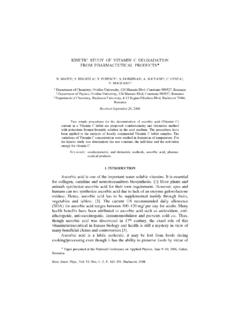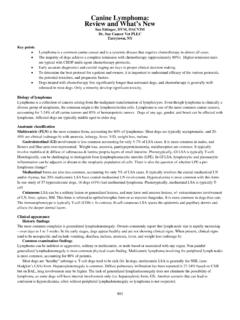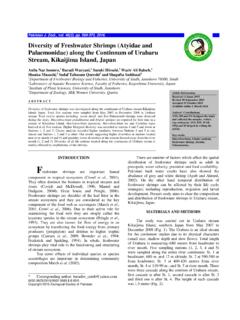Transcription of The Correlation between Rock Pool Size and Species …
1 Journal of Aquaculture & Marine biology The Correlation between Rock Pool Size and Species Diversity Volume 2 Issue 4 - 2015 jennah Williams*Department of Marine biology , Bangor University, USA*Corresponding author: jennah Williams, Department of Marine biology , Bangor University, 4421 Mariannes Ridge Rd Charlotte NC 28273, USA, Tel: 7046121880; Email: Received: May 14, 2015 | Published: September 1, 2015 Submit Manuscript | Aquac Mar Biol 2015, 2(4): 00035 IntroductionThe mid-shore zone of a rocky shore is home to many different Species of algae. Some Species have adapted to living in conditions of high salinity (Ulva spp and Porphyra umbilicalis), some have developed adaptations to survive in shallower waters (Chondrus crispus and Corallina officinalis) and some have adapted to thrive in exposed weather conditions (Laminaria digitata and Ascophyllum nodosum.)Research into the reasons seaweed populations are so diverse is numerous; with light intensity, temperature [1,2] and seasonal change [3] offering explanations as to the distribution of different Species .
2 The Jacobucci et al. [3] study highlights that certain seasons (winter in January and autumn in April) produce higher morphological characteristics of algae in shallower waters, furthermore the study showed that, in general, fronds tended to be shorter, heavier and more ramified in shallower areas . One of the final conclusions of the study sights depth as a major factor in the adaptation of the brown algae S. cymosum. Rock pool height in relation to sea level has also been investigated, showing correlations between Species diversity of algae [4], however Hayes [4] demonstrates that the number of algal Species in rock pools is negatively correlated with the height of the rock pools above sea level. Conditions in the higher shore area present increasingly harsher environments for marine algae to thrive in. Shallower rock pools in the higher shore area are more inclined to evaporate quickly, therefore increasing the salinity of the remaining rock pool water [5].
3 On the other hand, some rock pools formed on the upper-shore are frequently formed by rain water; therefore increasing the fresh water content percentage, this presents a challenge to the algae; to adapt to survive. Longer tidal absence also makes higher shore marine organisms an easier target for marine birds, reducing the numbers of algal Species in such mid-shore zone is also a particularly harsh place for organisms to survive. High wave action can dislodge marine organisms in this zone and transport them either lower down or higher up the shore, which could in effect place the organism in a less adaptable habitat for that particular creature and therefore cause reproductive/feeding or migratory problems. However Species living on the mid shore have an added benefit of not being dried out too severely even in high temperatures, compared to Species situated on the high shore, due to the incoming tides submerging them again ever few hours [6].
4 This is a huge advantage for mid shore Species and is a possible reason as to why the mid shore is such a highly diverse area of any shore for algal Species , when compared with other zones. This investigation looked to assess the relationship between rock pool area and Species diversity, on the mid-intertidal zone of a rocky shore, taking all these factors in to account to finalise whether rock pool area is the only relevant factor of total Species diversity on rocky shores around the coast of the British Isles. CaseThe experiment took place at Celmyn bay on the 26th October 2011. The rock pools were monitored on the mid-shore only, as the lower shore rock pools showed only one or two Species of seaweed and the upper-shore pools were all very small. The barrier of the mid-shore to upper-shore was calculated by the sudden increased number of barnacles showing where the mid-shore zone was and the separation between mid and lower shore was obvious as lower shore was under water at this time.
5 Random sampling of 35 pools took place, measuring length, width and depth with a tape measure and metre ruler to find the overall area of the pool. An even number of large pools where measured compared with small pools, to make this experiment fair. The different Species of algae were then identified, using an Identification card and recorded in a table. The pool sizes were also recorded in a table to compare Case ReportAbstractThe relationship rock pool area holds; when compared with the Species diversity of algae, was investigated on a rocky shore at Celmyn bay during mid-October 2014. Small experimental procedures were specifically designed to test whether the size of the rock pools recorded, made an impact on the total Species diversity that occurred on the mid-shore at low tide, to test the hypothesis that seaweed diversity; in large mid-shore level rock pools, would be greater than that of smaller mid-shore level rock pools.
6 Although during testing an apparent increase in diversity was noted in relation to increasing rock pool size, no significant difference was found between the two variables and the stated hypothesis of the investigation was shown by the results to be rejected in favour of the null hypothesis. Therefore emphasising that there may be outstanding factors which this study has not addressed, which may have an effect on the Species diversity of rock pools on a rocky shore. Keywords: Species diversity; Rock pool; Algae; Different Species ; Corallina officinalis The Correlation between Rock Pool Size and Species Diversity2/4 Copyright: 2015 WilliamsCitation: Williams J (2015) The Correlation between Rock Pool Size and Species Diversity. J Aquac Mar Biol 2(4): 00035. DOI: size of the pool to the diversity of Species found there. Species diversity is defined as the number and abundance of Species at one point at a defined period [7].ResultsFollowing this experiment, the results obtained showed, that the larger rock pools had significantly higher Species diversity when compared with the smaller rock pools.
7 However, the Species diversity failed to exceed 9 different Species in one area, no matter how large the rock pool was. This perhaps emphasises that the location of the rock pool is a major factor in Species diversity, as well as the size of the rock pool, as rock pools near the lower-mid shore showed a higher Species variation then pools of the higher-mid shore of the same size, a point further investigated within the discussion of the results. Figure 1 shows a weak, yet positive Correlation between the increase in pool size and the increase in Species diversity. However the greatest difference in Species diversity is between the pool size of and Pool sizes of larger value than then do not show a significant increase in the diversity of Species , again suggesting that pool size is not the only factor effecting Species population. Figure 1 also shows that the hypothesis has not been supported, as the P value is greater than (P= ), therefore showing no significant difference between the two variables, resulting in the acceptance of the null 1: Figure 1 shows the Variation of algal Species diversity with rock pool size.
8 Following the experiment the original result data had to be modified to portray an efficient figure, as the raw data collected was not appropriate when displayed in a graph form. The original data showed the surface area of 35 different sized rock pools (when measuring the length, width and depth to find the total surface area), evidently providing numbers of huge differences ( ) this data was therefore inappropriate to be presented in a graph and had to be square rooted to make the results more similar, however as the results were still too different to be valid in a graph, the results were then logged (Ln) so they were then on a scale that would be more comparable in a graph. The R2 value portrays slight Correlation , showing that there is some Correlation however it is weak. The points recorded are not very close to the trend line, presenting a suggestion that the size of the rock pool is not the only factor affecting the results, if it was so, one would expect the R2 value to be approximately 9.
9 The gradient of the trend line is calculated at , emphasising a shallow increase of the Species diversity of algae in comparison with the size of the rock pools. Figure 1 also shows that the trend line would be intercepted on the X axis at approximately at Ln2, hypothesising a possible complete decline in algal numbers below rock pool sizes of Ln2, this being said, due to the fact that the R2 value is , there is a possibility of potential outliers; occurring above or below the trend line after interception. This highlights the fact that different factors need to be taken in to account before relying on data and that some findings should not necessarily be taken at face value. When the results had been collected and analysed, it was apparent that certain Species were more abundant than others, regardless of the size of the rock pool, Citation: Williams J (2015) The Correlation between Rock Pool Size and Species Diversity.
10 J Aquac Mar Biol 2(4): 00035. DOI: Correlation between Rock Pool Size and Species Diversity3/4 Copyright: 2015 Williamsunderlining again that there may be are other factors accountable for diversity of Species , in conjunction with different pool 2 shows the most common Species that occurred at the mid-shore zone of the rocky shore in the rock pools recorded Corallina officinalis, a small red algae, generally distributed across rocky shores all around the British Isles (that typically forms a turf in rock pool from the mid- tidal level to the sub-littoral fringe). In all cases it was the most frequently recorded Species in the pools. Pools between Ln 8 and Ln 10 the highest number of recorded Species , this could have been because of where on the mid-shore the pools were recorded for example lower-mid shore, or the fact that algae can thrive in this sized pool, again Corallina officinalis was the most frequently recorded Species , however this Species normally only flourishes on exposed shores, therefore if the experiment was done elsewhere, the results may differ.
